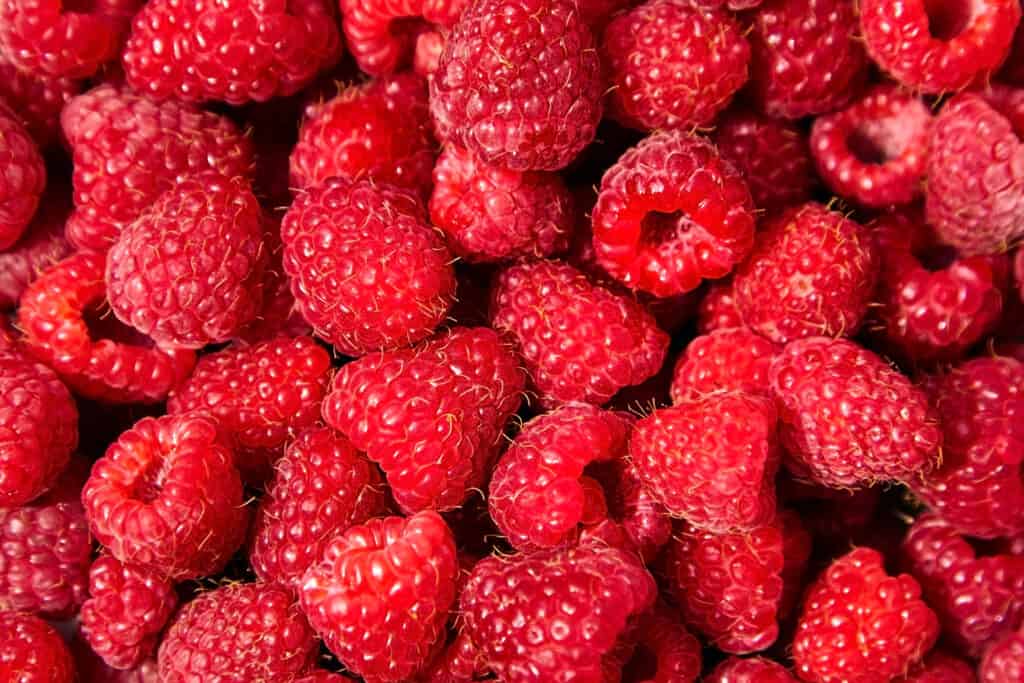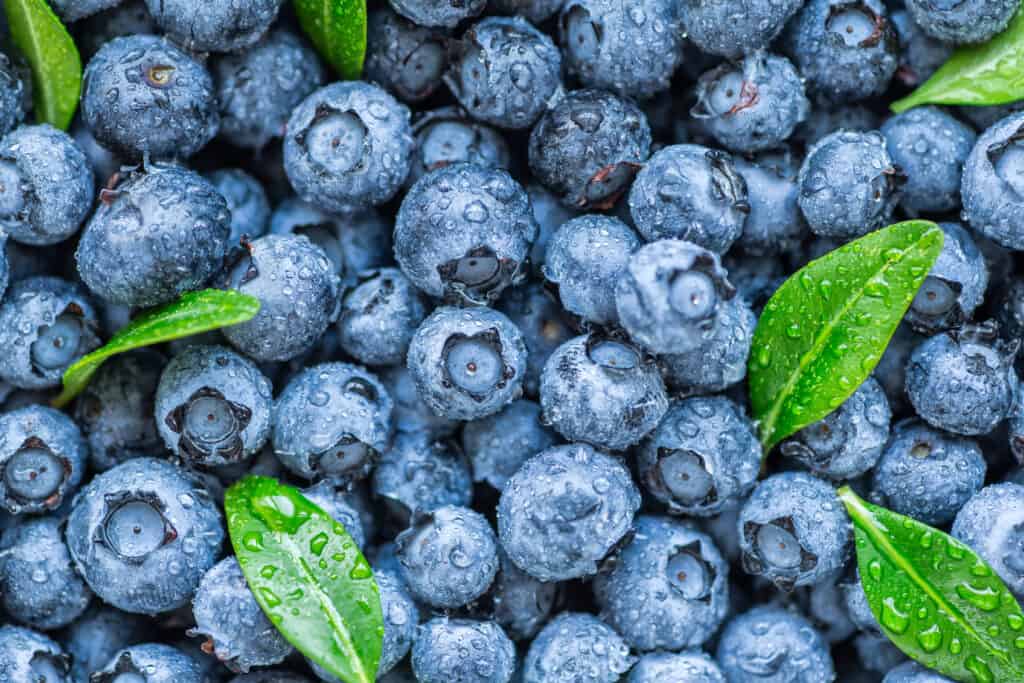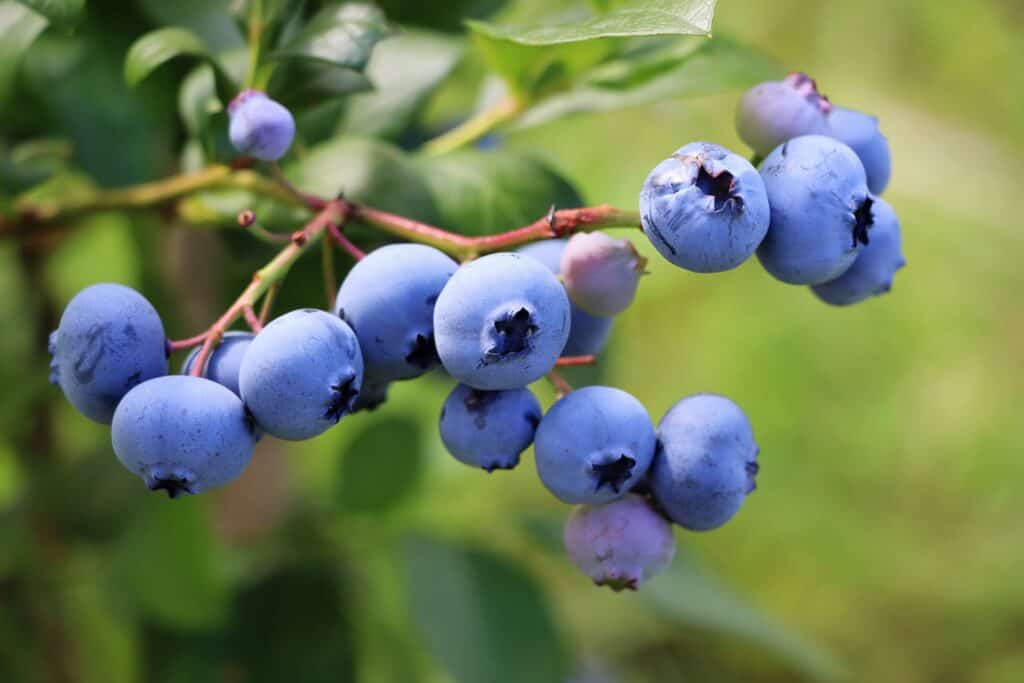Everyone is familiar with the culinary uses of these two popular berries, but most folks don’t know that they grow on entirely different types of plants. They are straightforward to tell apart when they are side by side because they look completely different from each other, even when not in bloom or covered in fruit. We will discuss the similarities and differences between these two berry plants in more detail below.
Comparing Raspberries vs. Blueberries

Raspberries have small star-shaped flowers that are a purplish color.
©Mike_O/Shutterstock.com
| Characteristic | Blueberry | Raspberry |
|---|---|---|
| Scientific Family | Genus Vaccinium, along with cranberry, bilberry, and huckleberry | Genus Rubus, along with roses |
| Plant Description | Perennial flowering bush with shallow roots. Ranges from four inches to 13 feet high | Perennial roots with biennial canes. Canes are woody and have thorns. Ranges from four to six feet high |
| Leaf Description | Oval or lanceolate. 1/2″ to 3 1/4″ long leaves | Alternet leaves 3 to 5″ long. 3-5 leaflets with serrated edges |
| Flower Description | Bell-shaped flowers are white, pink, or red | Star-shaped flowers with 5 petals are purple with yellow centers |
| Berry Description | Lowbush has small berries 3/16″. Highbush has larger berries 5/8″. Berries start green and ripen to blue. Covered in a powdery protective coating | Each berry is 1/2″ to 1″ and made of 100 drupelets. Each drupelet contains fleshy pulp and a seed. Raspberries have hollow cores |
| Origins | Native to North America | Native to north Asia, Europe, and North America |
| Growth Requirements | Sandy or loamy soil. Mulch to protect shallow roots. 8+ hours of sun per day. Plant in fall | Plant in winter when dormant. Rich soil. 8+ hours of sun per day |
| Time of Fruit | Produces fruit from May to August, depending on the variety | Produces fruit in June or July for five weeks |
| Yield | Up to eight quarts of berries per bush | Up to two quarts of berries per bush |
| Macros per 3.5 oz (100g) | 14% carbohydrate. 0.7% protein. 0.3% fat. 84% water | 12% carbohydrate. 1% protein. 1% fat. 86% water |
| Uses | Fresh, frozen, juice, puree, dried, infused, jam, baked goods | Fresh, frozen, dried, jam, yogurt, smoothie, baked goods. Leaves are edible. |
| Propagation | Propagate by stem cuttings | Propagate by basal shoots |
Key Differences Between Raspberries and Blueberries
The key differences between raspberries and blueberries are their scientific families, appearance, and uses. Other differences include care, fruit timing and yield, and propagation.
Raspberries vs. Blueberries: Scientific Family

Blueberries are a member of the
Vacciniumgenus.
©Bukhta Yurii/Shutterstock.com
Raspberries are a member of the rose family. This genus is characterized by its woody stems with thorns, spines, bristles, and gland-tipped hairs. Raspberries are often called cane fruit, cane berry, or bramble fruit.
Blueberries are a member of the Vaccinium genus. Members of this genus are all fruit-producing shrubs. Most grow in a prostrate pattern and come in many different sizes. The majority of shrubs in this genus have woody stems and prefer acidic soil to produce the most fruit.
Raspberries vs. Blueberries: Appearance
Raspberries look more like a pile of long vines than a bush. If left to their own devices, they will grow into a snarl of impenetrable thorns. Raspberries have small star-shaped flowers that are a purplish color. The fruit is dark pink or red and comprises 100 tiny drupelets, each containing a seed.
Blueberries are a traditional-looking shrub; when not in flower, they make a handsome prostrate garden ornament. Some varieties grow along the ground to only 4-12 inches. The most common blueberries in garden centers are 3-5 feet high. The flowers of a blueberry bush are bell-shaped and white, pink, or red. The berry starts out green and ripens to a dark blue color. Each fruit is perfectly round and smooth with a white powdery protective coating. This hydrophobic coating is called epicuticular wax.
Raspberries vs. Blueberries: Care

Raspberries need nutrient-rich soil with a large amount of organic material.
©Nitr/Shutterstock.com
Of the two berry bushes, raspberries are the more challenging to care for because they require frequent pruning. The roots of raspberries are perennial, but the canes are biennial; you have to prune out the old woody canes to allow new canes to grow and produce fruit. Left unpruned, they grow into a tangled mess that creates a shady environment, less fruit, smaller fruit, and fruit that is much harder to pick.
Raspberries need nutrient-rich soil with a large amount of organic material. It is best to plant them single file along a fence or trellis so you can tie the long canes up off the ground. Trellising makes for easier picking, easier pruning, and more sunlight. Raspberries need eight hours of sunlight per day to thrive.
Blueberries are easy to grow. The biggest consideration when planting is that most blueberries prefer acidic soil. They also have shallow roots, so be sure to remove all weeds from the area, as you will damage the roots if you try to pull weeds or use a garden tool after planting. These shallow-rooted shrubs grow very well in a pot or raised bed.
Blueberries require no pruning for the first several years. After that, prune any dead, broken, or weak branches to keep the bush solid and tidy. No matter where you plant them, providing a thick layer of mulch is an excellent idea to protect the roots near the surface. Provide your blueberries with sandy, loamy soil and eight hours of sunshine daily, and they will thrive.
Raspberries vs. Blueberries: Fruit Timing and Yield
Raspberries come in a summer-bearing variety or an ever-bearing variety. The summer-bearing type fruits in June or August and produces berries for about five weeks. The ever-bearing variety has a light harvest in June and a heavier harvest in September. You can expect between one to two quarts of berries per plant.
Blueberries produce fruit in July and August. The fruit turns a dark blue and will come off the bush with a very gentle tug. If the berry is difficult to pull from the stem, it isn’t ripe yet; wait another day or two. You can expect a yield of six to eight quarts of blueberries per bush. However, many dwarf hybrids produce only one or two quarts per bush.
Raspberries vs. Blueberries: Uses

Blueberries are a traditional-looking shrub; when not in flower, they make a handsome prostrate garden ornament.
©vaivirga/Shutterstock.com
Cooks use raspberries and blueberries in many of the same ways. They are both used in desserts and jams because of their sweet flavor. You can freeze or freeze-dried them easily for storage. They are favorites in baked goods, smoothies, and toppings for yogurt and ice cream.
One difference in use is in color; when stirred into a batter, blueberries tend to turn the baked goods a grayish-blue color. Another consideration is raspberry seeds; raspberries contain a large number of seeds that are hard to remove from the finished product. So if you don’t like seeds in your jam or pie, a different berry might be a better choice.
Raspberries vs. Blueberries: Propagation
Raspberries are almost too easy to propagate. They are nearly invasive in some areas. They will happily cover a large area by spreading along the grown via basal shoots, otherwise known as suckers. If you want to save money, you can purchase one raspberry plant and turn it into dozens of free plants by waiting for the suckers to form, digging them up, and preparing them in a separate area.
Blueberries, on the other hand, are a bit more difficult to propagate. You propagate by taking soft-wood or hard-wood cuttings from a healthy and robust mother plant. The cuttings are then rooted and replanted in a separate location. Sometimes this process takes more than one try but is well worth the effort. It is worth noting that some of the older cultivars do produce a small number of suckers, so keep an eye out for those free offshoots.
NEXT UP…
- Highbush Blueberry vs. Lowbush Blueberry
- Bilberries vs. Blueberries: What’s the Difference?
- Boysenberry vs Blackberry: Is There a Difference?
- Black Raspberry vs Blackberry: Is There a Difference?
The photo featured at the top of this post is ©
Thank you for reading! Have some feedback for us? Contact the AZ Animals editorial team.






